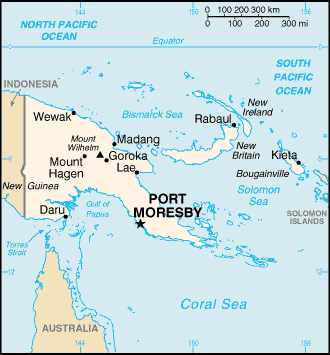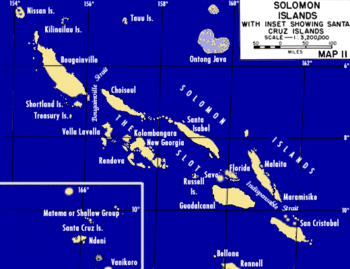Papua New Guinea
Papua New Guinea is a nation in Oceania, made up of a group of islands between the Coral Sea and the South Pacific Ocean, east of Indonesia. The largest land mass is the eastern half of the island of New Guinea.
It is part of the Commonwealth of Nations. Port Moresby is the capital.
While the area is rich in natural resources, it severely lacks infrastructure; 75% of the population subsist on agriculture. Australia supplied more than $300 million in aid in FY07/08, which accounts for nearly 20% of the national budget; relations with Australia are still challenging. A consortium led by a major American oil company hopes to begin the commercialization of the country's estimated 637 billion cubic meters of natural gas reserves through the construction of a liquefied natural gas (LNG) production facility by 2010. The project has the potential to double the GDP of Papua New Guinea.
It has the the highest HIV/AIDS rate in all of East Asia and the Pacific, and chronic law and order and land tenure issues.
Papua New Guinea is an "observer partner" of the Association of Southeast Asian Nations (ASEAN), but wants full membership. [1]
Second World War
Many areas within its boundaries were important in the Second World War, including the Bismarck Sea, Admiralty Islands including Manaus Island, Bougainville, Guadalcanal, Rabaul, and the Solomon Sea. The first priorities dealt with neutralizing the threat, in 1942, to Australia. [2]
A priority of the Japanese, in mid-1942, was to take Port Moresby, a key Australian base in southeast New Guinea. It guarded Australia's vital Melbourne-Brisbane coastal belt, the Commonwealth's most thickly populated and most highly industrialized area.
The first attempt was turned back by the U.S. Pacific Fleet at the Battle of the Coral Sea; the second resulted in the Papuan Campaign, one of the longest and most bitterly fought campaigns of the Pacific War. The fight ostensibly was for Port Moresby, but it was Australia, no less than Port Moresby, which was in danger.
At first, the ABDA (American, British, Dutch, Australian Command) (ABDACOM), "under Gen. Sir Archibald P. Wavell of the British Army, and then Commander-in-Chief, India, was put in supreme command. of the area including Port Moresby. "Named as his deputy was Lt. Gen. George H. Brett, at the time Commanding General, United States Army Forces in Australia (USAFIA). USAFIA, a small hastily improvised service command a few weeks old, was engaged, on the one hand, in largely barren attempts to get supplies through to the Philippines by blockade runner and, on the other, in providing for the supply of American air units striking at the enemy from Darwin and advance bases in the Netherlands Indies. General Wavell was given as his principal mission the task of holding the Malay Barrier, a defensive line which included the Malay Peninsula, Sumatra, Java, and Timor and extended eastward from Timor to the coastal waters of northwestern Australia. Australia (specifically excluded from the ABDA Area at the time) was to be used as "an essential supporting position".
Before long, the role of USAFIA was to be a supply echelon for ABDA. " Australians were left to defend the island continent's eastern and northeastern approaches as best they could using their own resources, the assumption at the time being that Australia was safe as long as the Barrier held.
The trouble was that Australia was, if anything, even more exposed from the northeast than from the northwest. What was more, it had heavy obligations there, being responsible for the defense of territories in New Guinea, the Bismarck Archipelago, and the Solomon Islands. Its two territories in New Guinea--Papua, a territory of the Commonwealth, and North East New Guinea, a part of its New Guinea Mandate--together made up the eastern half of that immense island, the rest being controlled by the Dutch. Its mandated territory also included New Britain and New Ireland in the Bismarck Archipelago and Buka and Bougainville in the northern Solomons. It was, in addition, responsible for the defense of the British, or southern, Solomons, the whole New Guinea-Bismarcks-Solomons defense zone being known as the Northeast Area. "[3]
References
- ↑ ASEAN Summit Seeks Increased Regional Links, Asia Briefing Ltd.
- ↑ Samuel Milner (1957), Victory in Papua, vol. United States Army in World War II: The War in the Pacific, U.S. Army Office of the Chief of Military History
- ↑ Milner, pp. 2-3

